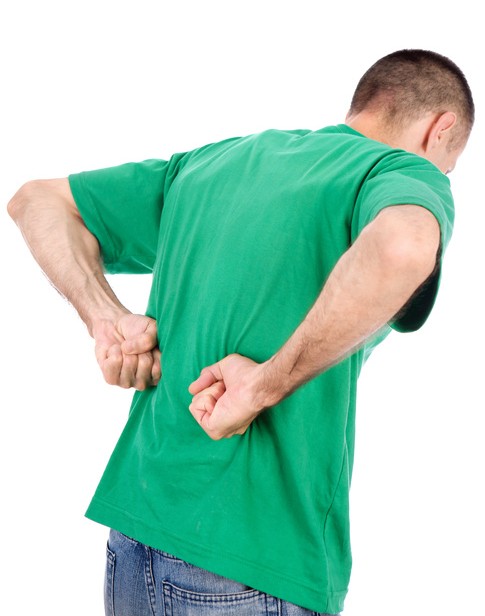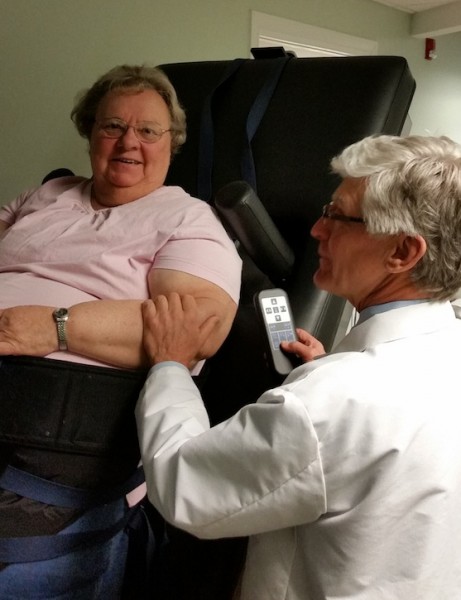Back pain, especially low back pain. One of THE major reasons people miss work or become disabled. Men and women alike.
Why do people’s backs hurt?
A few possibilities:
- Being out of shape
- Getter older
- Carrying too much weight
- Sitting or standing all day
- Lifting heavy objects and/or lifting the wrong way
- Smoking
- A terrible mattress
There are several specific causes of back pain. Some of the more common causes are:
- Degenerative disk disease or arthritis
- Herniated or ruptured disk
- Muscle spasms
- Compression fractures caused by osteoporosis
- Spinal stenosis
- Sciatica
- Back injury
Some people develop back problems because of:
- Congenital issues
- Cancer
- Infection
Elsie’s story
Fortunately, most people’s back pain goes away on its own. For some people, though, it becomes a chronic condition. That’s what happened to Elsie Cebulla, who’s in her 70s. She’s had a backache for at least 15 years.
“I really don’t know how I hurt my back,” she told me. “I enjoyed working with wood and making furniture. I would go and stand on concrete and bend over and do the sanding and the cutting and all that. I’d be down at 8:30 in the morning and I would forget myself and wouldn’t be back in the house until 4:30 or 5:00. As time went by I noticed, gee my back hurts.”
Elsie tried physical therapy, cortisone injections, acupuncture, plain old ice and heat and Ben Gay. She was not interested in painkillers, would rather deal with the pain. She took them for a day after knee replacement surgery and didn’t like the way they made her feel. She was told she might need back surgery. Her reply: “Not in this lifetime.”
Spinal decompression
Instead, Elsie decided to have a go at something called non-surgical spinal decompression. Her husband had a course of treatments for his back pain. “It helped him,” she said. “He’s no longer sitting in pain with ice or heat. He’s now chopping wood.”
Non-surgical spinal decompression is a form of traction that slowly stretches (loads) and then relaxes the spine. Putting a load on the targeted disk or disks creates a negative pressure. The ultimate goal is to relieve pressure on those disks, as well as nerves and other structures that may be contributing to the pain.
On average, people are treated three times a week for up to eight weeks. Total cost is between $3500 and $6000, not always covered by insurance.
Elsie is being treated by Dr. Douglas VanderPloeg, a chiropractor who runs the Maine Spine & Nerve Institute in Scarborough. She begins each treatment standing with her back against an upright table. Special harnesses are fitted around her pelvis and chest. She is made as comfortable as possible and the table is lowered so that she is lying flat.
Dr. VanderPloeg then sets a predetermined program that will last for 30 minutes. Stretching and relaxing. Stretching and relaxing. “In my particular case, it feels wonderful,” says Elsie.
Ordinarily, if you stretch a sore area, the muscles around it will tighten up to protect the area. Decompression makes the muscles stay relaxed, says Dr. VanderPloeg. “We learned how to fool the receptors in the muscles so they don’t interfere with our ability to place a load deeper in the spine and that’s a big difference. With decompression, we can target the load to a particular disk, do it for a longer period of time and specifically control the load that is used.”
While the treatment itself feels good, Elsie is often sore afterward. “Today was a treatment,” she told me the day we talked. “I’m home now, and it hurts to walk. Not as bad as it was before I started the treatments, though.”
“Patient tolerance is important,” says Dr. VanderPloeg. “They might say that felt great but the next day they might be so sore they can barely move. Those are the types of things we want to avoid so we start with a lower load and gradually titrate up to patient tolerance. A little soreness is acceptable. Pain is not. There is a difference.”
Not all people with low back pain are candidates for spinal decompression. It’s primarily for someone with a bulging or herniated disk, degenerative disease, sciatica or facet syndrome. It is not a treatment for osteoporosis or if you hardware in the area being treated or are pregnant.
“Most of the people we see have failed multiple things before they get here and most have had pain for a significant part of the time,” says Dr. VanderPloeg. “A lot of them have been taking pain medications for a long time. They’re trying to get themselves to a point where they can function. I want them to know there’s another option.”
As for Elsie, she says her pain has lessened considerably and that it’s easier to get around. She still has a few more treatments to go and while she doesn’t expect to be totally pain-free, she does have one expectation — that she’ll be able to enjoy some camping trips this summer. “All I want,” she says, “is to be able to crawl in and out of my motor home this summer!”
As you should do before you opt for any kind of treatment for any medical problem, if you have back pain, it’s important to get an accurate diagnosis first to figure out what’s causing your pain.



This experience caused me pain and now ruined my credit. He makes you go thru a third party that pays him and if he hurts you he still gets his money. There is a reason insurances won’t pay for this treatment ,I believe it was a scam in my case. The treatment caused me enormous pain once they finally did some stretching, the first 5 treatments never did any stretching but they said you just don’t feel it. That guaranteed him payment at least for those first treatments .After suffering the pain to a point where I was dragging my left leg I went to see Dr.Regan in Auburn. Dr.Regan operated which fixed the problem..